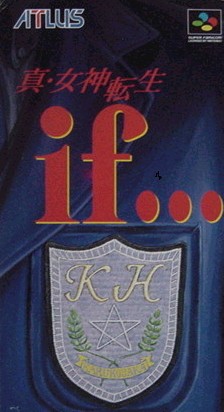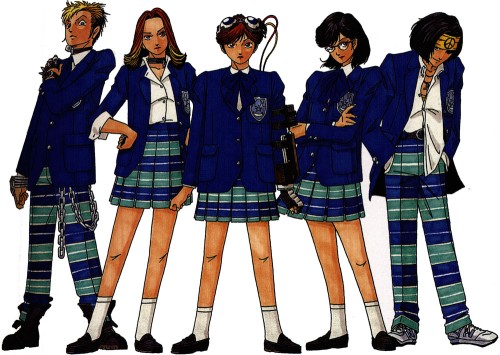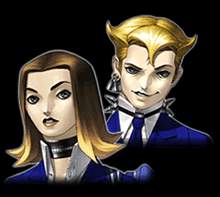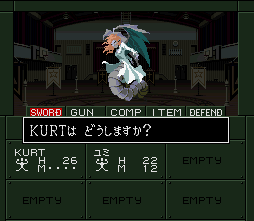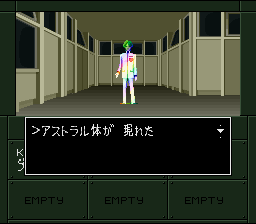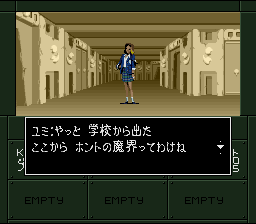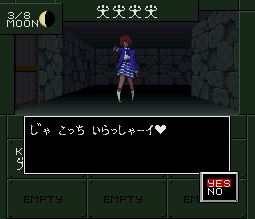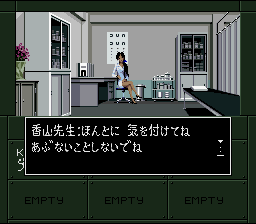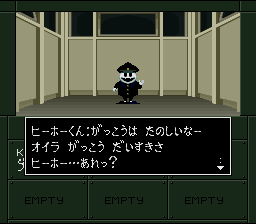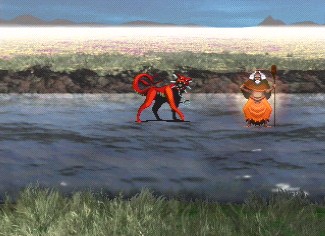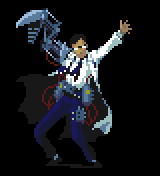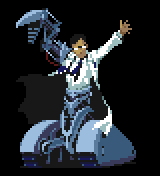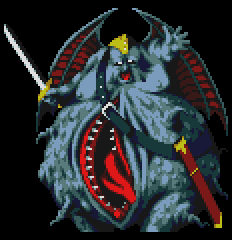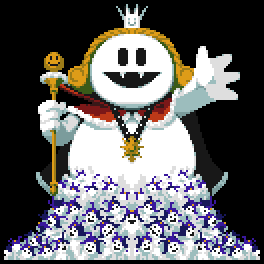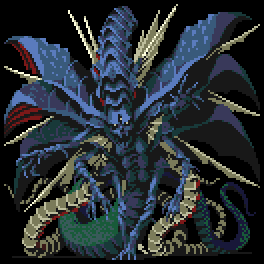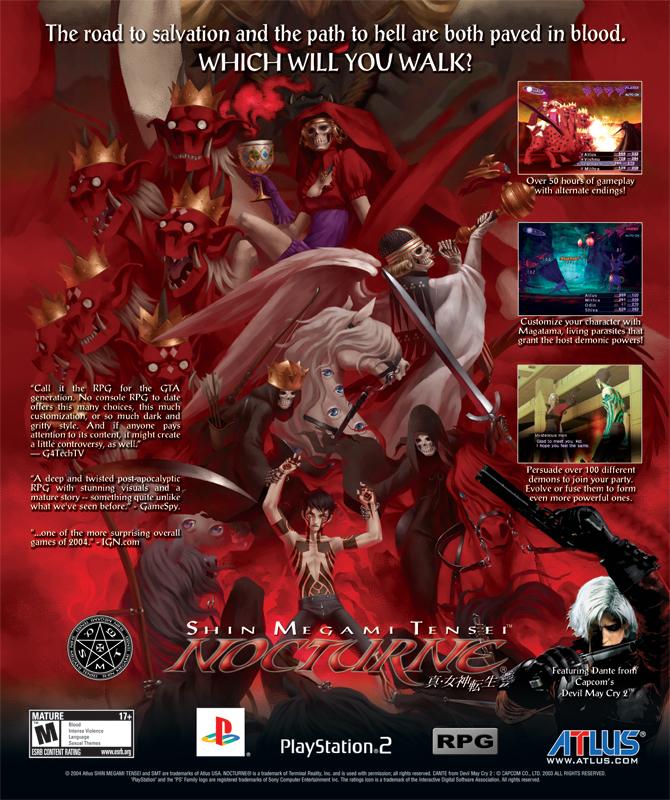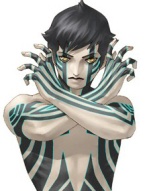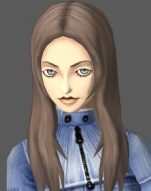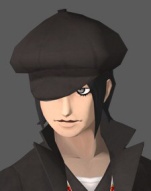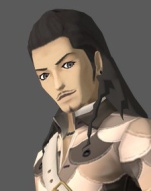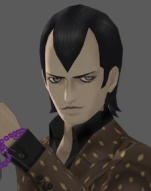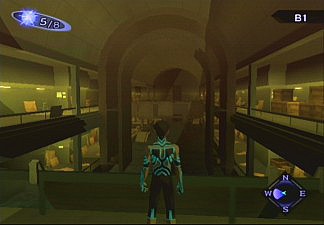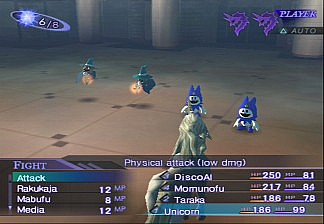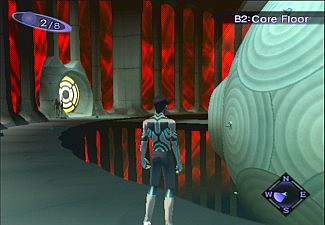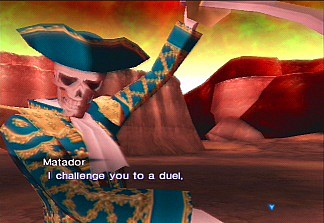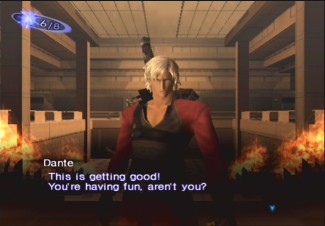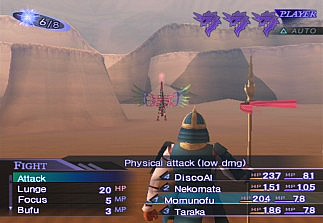
Shin Megami Tensei
Megami Tensei / Shin Megami Tensei
|
Page 1: |
Page 2: |
Page 3: |
Page 4: |
|
Shin Megami Tensei if... (真・女神転生if...) - Super Famicom, PlayStation, Windows, iOS, Android, Wii Virtual Console (1994)
Shin Megami Tensei if... is a sidestory to the other Super Famicom games, rather than a direct sequel - it's basically a "what if?" scenario if Tokyo hadn't been destroyed back in the first Shin Megami Tensei. Shin Megami Tensei if... takes place in Karukozaka High School, which is mysteriously warped off into the realm of Makai (the demon world.) If the strange void outside of the school weren't enough, you see visions of a student named Hazama - a rather shady fellow who disappeared recently, but now claims to be the ruler of Makai. After equipping yourself with shoulder pads and other sportsgear from the gym locker, it's up to you to venture through the world of the demons, investigate Hazama's role in this, save yourself, and maybe save your educational institution. While you spent some time in Makai briefly in the original Shin Megami Tensei, SMT if... lets you explore more into the world of demons - there are five worlds, based on the seven deadly sins (yes, some of them are missing.)
Shin Megami Tensei if... is the only game in the series that doesn't assume that you're a guy - in fact, you can actually choose your gender. Your opening stats are determined by a creepy fortune telling machine, who asks you questions similar to Ogre Battle, although of a much simpler nature (do you like video games, do you do your homework, etc.) The game's heroine appears in the Persona games with the name Tamiki.
Almost the entire soundtrack (and some of the graphics) are lifted and remixed from the first two games, making this feel like more of an expansion pack than a true sequel. The janitor is actually the same graphic as the gladiator from SMT II - even his theme music is the same. Whether this was an intentional joke or just laziness is beyond me. However, there are plenty of gameplay differences to distinguish itself. No longer is your ending path chosen by your alignment - instead, at the beginning of the game, you can choose to ally yourself with one of four fellow students. Whoever you pick will somewhat alter the course you take through the game, with each path exploring the plotline of your chosen partner, taking you through different dungeons and ultimately deciding the ending. So while SMT if... is quite a bit shorter than the other games, there is at least a heavy replayability factor.
(From left to right): Charlie, Yumi, Tamiki (heroine), Reiko, Akira
The other major addition is the Guardian System. In Shin Megami Tensei II, when you died, you were escorted across the river by Charon, then booted back to the title screen so you can reload your last saved game. Not so here. When either one of your human characters is killed, they are granted a Guardian Spirit, then whisked back to the last fountain of life. This Guardian can alter the statistics when you gain a level - if they have a higher power rating than you do, you'll gain a little bit of extra strength. It works in the opposite direction too - if they have a lower magic ranking, you'll lose magic strength. They'll also alter the magic skills of your human partner. It's an interesting system, although it's a little weird to have to kill yourself under certain conditions so you can get a different Guardian.
The if... in the title refers to the constant "what if" statements used in the games intro and ending narratives. It also may be inspired by the British 1968 cult film If..., about a boarding school with many dark secrets. The font used for the movie title is identical to the one used on the SMT if... cover. The high school setting and the concept of monsters guarding your characters is undoubtedly the inspiration behind the Persona series. As much fun as it is to fight demon professors, SMT if... lacks the driving plot or philosophical/religious quandaries of the other two games, it's still pretty good.
Just like Shin Megami Tensei and II, if... was granted a remake for the PlayStation, including the usual enhancements and two difficulty levels. A special edition was released with a large box and a DVD with interviews about Shin Megami Tensei: Nocturne. Apparently there was also a special chapter of the game released for cellphones starring Hazama.
Quick Info:
|
Developer: |
|
|
Publisher: |
|
|
Designer: |
|
|
Genre: |
|
|
Themes: |
Shin Megami Tensei if... (Super Famicom)
Shin Megami Tensei if... (Super Famicom)
Shin Megami Tensei if... (Super Famicom)
Shin Megami Tensei if... (Super Famicom)
Shin Megami Tensei if... (Super Famicom)
Shin Megami Tensei if... (Super Famicom)
Shin Megami Tensei if... (PlayStation)
One of the recurring bad guys in SMT If... is your science teacher, Ohtsuki-sensei. He's one of the first bosses you fight, but as you fight him later in the game, he starts adding mechanical parts to his body until he's nothing but a giant mech with a human head. It's an interesting display of Megaten's bizarre sense of humor.
Some other cool bosses from the SFC Shin Megami Tensei games (from this site):
Shin Megami Tensei III: Nocturne (真・女神転生III-NOCTURNE) / Shin Megami Tensei: Lucifer's Call - PlayStation 2, PSN (2003)
It took nearly a decade, but the third game in the true Shin Megami Tensei series was finally released for the Playstation 2 in 2003. In a similar setup to the first game, SMT: Nocturne puts in the role of a Japanese boy who survives the Conception, an apocalypse which is in preparation for the rebirth of a new world. Reborn as a demon, you learn that some of your friends are still alive - including your school teacher, who is one of the people that brought about this destruction. As you explore the wastelands of shattered Tokyo, you learn that you may be the chosen one, the demon to shape the new world. Unlike the other SMT games, where you are simply divided between Law, Chaos and Neutral, SMT: Nocturne allows you to ally yourself with the philosophies of the other players in the game, or simply make your own path.
Hero
The main character whom you get to name. After the Conception, you awaken, transformed into a demon. Fate has bestowed upon you the ability to change this new world.
Chiaki
One of the hero's schoolmates, Chiaki seems unharmed initially, although she does harbor something darker. Chiaki eventually follows the path of "Yosuga", or the Darwinian "might makes right" philosophy.
Isamu
Another of the hero's classmates that survived the Conception, Isamu follows the reason of "Musubi", a philosophy focused on individuality.
Hijiri
The writer for a magazine on the occult, Hijiri still remains alive after the Conception, despite not being the school. He seems to enjoy exploring the new world. Although Hijiri never fights, he is always helping the Hero, especially in uncovering the mysteries of the terminal.
Hikawa
Hikawa is the leader of the cult that brings around the Conception. He rules the Assembly of Nihilo, Hikawa follows the reason of "Shijima", which is very similar to the "Law" alignment of the previous games.
Nocturne is a split between the original old school games and more modern RPGs. It's still maddeniningly difficult (wait until you fight any of the Fiends), and you'll need to spend a lot of times hunting and fusing demons to get just the right spells you'll need to beat certain enemies. The dungeons are tremendously large, and save points are sparse. Some things have changed tough, as the game is now entirely third person, including the battles. All of the cyberpunk elements are gone - you no longer use computers to summon demons, seeing as how you're a demon yourself (and an awesome looking one at that.) Demons now gain experience, although not very quickly, so fusing them is still important.
Speaking of which, the fighting has been given a complete overhaul as well. Completely new is the Press Turn system - if you hit an enemy with attack they are weak to, you'll get an extra turn. On the other hand, if you use a spell that an enemy is invulnerable to, you lose a turn. Naturally, the same principles apply to your party, so much of the strategy revolves around carefully balancing your demons to properly exploit this. Paying attention to character elemental strengths and weaknesses has always been a big part of the SMT games, but now it's even more important.
For the first time, a Shin Megami Tensei game actually has decent production values. Kankeko's character designs were first rendered in 3D in Maken X, but they look particularly breathtaking here. The landscapes, while not extraordinarily varied, have a unique style to them that oozes demonic creepiness, whether you're exploring deserted shopping malls or making your way through expansive hallways of demonic architecture. Parts of the game is seen through a hazy filter, thoroughly amplifying the nightmare-ish effect of the world. While there's no voice acting, the music is incredible - the hard rock battle themes (mixed with appropriately demonic voices blaring) are something you rarely hear in an RPG. There are several battle themes, and each one has several variations with different riffs, making each fight an savory aural delight. For some reason though, the sound quality in the battle scenes is in noticeably low quality. The rest of the soundtrack, mostly atmospheric mood music (along with a few arrangements of old songs) is almost as amazing.
While the plot can be slow to unfold beyond the beginning, and certain bosses will kick your ass for hours, the incredible amount of depth in Shin Megami Tensei: Nocturne guarantees that anyone who's really into RPGs will get themselves lost in this incredible game.
Nocturne got a "director's cut" rerelease under the name Shin Megami Tensei III: Nocturne Maniacs. It adds several new monsters (including the Fiends, many of which are from previous Megaten games), an extra final dungeon (which opens up a sixth ending),and balances many gameplay aspects, mostly in making the game a little bit less unfair. The most hyped addition is the addition of Dante from Capcom's Devil May Cry series. Taking the role of a demon hunter, he hunts you down at the beginning, and depending on your alignment, will either continue to haunt you throughout the game, or join up with you at near the end. It's a relatively minor addition, and some hardcore SMT fans feel that Dante's presence is out of place, although it is cool for fans of Capcom's action series. Thankfully, Nocturne Maniacs was the version that Atlus chose to localize and release in English - the first true Shin Megami Tensei game to reach outside of Japan, although they dropped the "III" from the title. First print runs even included a single CD soundtrack with most of the best songs from the game. The PAL version is subtitled "Lucifer's Call".
A third version of the game was released in Japan in 2008, bundled only with the special edition of Devil Summoner: Raidou Kuzunoha vs. King Abaddon. It's essentially just the Maniacs edition, with Dante being replaced by Raidou.
Quick Info:
|
Developer: |
|
|
Publisher: |
|
|
Designer: |
|
|
Genre: |
|
|
Themes: |
Shin Megami Tensei: Nocturne (PlayStation 2)
Shin Megami Tensei: Nocturne (PlayStation 2)
Shin Megami Tensei: Nocturne (PlayStation 2)
Shin Megami Tensei: Nocturne (PlayStation 2)
Shin Megami Tensei: Nocturne (PlayStation 2)
Shin Megami Tensei: Nocturne (PlayStation 2)
Shin Megami Tensei: Nocturne (PlayStation 2)
Shin Megami Tensei: Nocturne (PlayStation 2)
Shin Megami Tensei: Nocturne (PlayStation 2)
Additional Screenshots
Megami Tensei / Shin Megami Tensei
|
Page 1: |
Page 2: |
Page 3: |
Page 4: |
|
